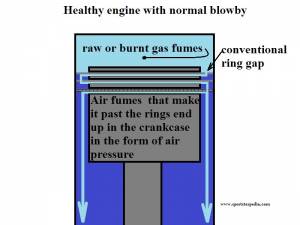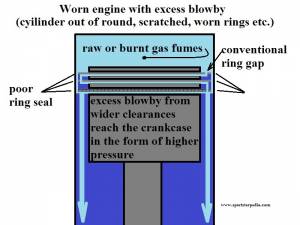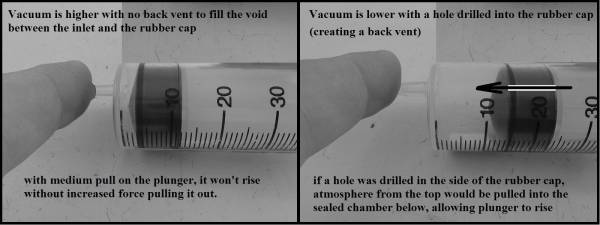Table of Contents
This is an old revision of the document!
REF: Engine Mechanicals - Sub-07D
Blowby and Ring Seal
Blowby pertains to the condition of ring seal at the cylinders / pistons.
Combustion above the piston is pushed past the rings and into the crankcase.
It is fundamentally just exhaust that went past the rings instead of out the exhaust port. 1)
It's depleted of oxygen, it's hot, and it picks up moisture and oil in it's travels through the crankcase and into your intake tract.
So it's displacing oxygen in the intake charge (through the air cleaner) that would otherwise contribute to combustion.
It also heats the intake charge when the breather vent is piped back to the air cleaner which contributes to detonation.
It's just a bad thing all the way around, robbing power, causing detonation, and contributing to carbon build-up.
It's well worth it to remove it from the intake tract and vent it to the atmosphere or exhaust instead.
What actually 'blows by' the rings and into the crankcase is a mix of unburnt fuel, water, soot, acids etc. 2)
Regarding blowby at high revs, the key factor is ‘ring-flutter’ or ‘ring-seal’. 3)
Starting with a dead cold engine, there’s no blow-by measurable for a time after start-up.
Then at warm idle, it starts. Above idle it either drops off or holds constant, as revs go up.
Ring seal improves above idle.
As you get near peak revs, ring-seal again fails and gusts of blow-by pass down into the crankcase.
Combustion chamber blowby adds positive pressure to the crankcase at the same time it's being lowered by the vacuum condition on piston upstroke.
The greater the blowby, the more it pressurizes the crankcase during this period.
By design, we have a little blowby bridging the gap between positive and negative pressure on piston upstroke also.
However, without the addition of blowby during this vacuum period, seals and gaskets could be in an imploding type position.
That could stress the seals enough to pull outside atmosphere through the gasket / seal areas and into the engine during upstroke.
(adding more air into the system only to regenerate higher on downstroke)
Example:
If you put your finger on the end of a syringe and pull the plunger up, you get an indent in your finger from the suction on the end.
If you were to drill a small hole in the rubber cap on the plunger, you would not get the indent (or suction) on your finger.
The air between the rubber cap and your finger would be equalized by the air coming into that area from the outside (through the small hole).
The hole in the rubber cap on the plunger referenced above represents ring seal.
So a certain amount of blowby is needed to fill the air volume in the crankcase to just below atmospheric pressure, but not greater.
If blowby charged the crankcase with positive pressure on upstroke, the breather would open prematurely while splash and oil mist is being pulled up.
This positive air / oil charge would be amplified upon the next downstroke which normally opens the breather.
Then it darts toward the low pressure in the system which is the breather opening = oil puking out the A/C.
Ring construction
Gapless rings:
We've just historically had trouble with wet sumping when using gapless rings. 7)
Basically, the better your ring seal, the more likely you are to have a wet sumping issue.
A lot of guys who work on a lot of gas/diesel/car/truck/bike/old/new performance stuff have moved away from the gapless second ring. 8)
It traps pressure under the top ring.
In fact the trend has become to run the gaps looser on the second ring to allow what gets thru the top to not get stuck.
New ring / cylinder install
Neither new rings nor cylinder bores are perfectly round. 9)
As a result, when you put a new ring on a piston and into a new bore, there's actually very little surface area of contact between the two.
The honing process puts a texture on the cylinder wall that allows the ring to machine the wall into the same shape as the ring during operation.
This increases the surface area of the contact patch.
The ring is said to be “seated” when it has carved the cylinder into it's shape and there's contact all the way around.
Many, many times I've pulled bikes apart and looked at the cylinder walls and spotted places where the ring was never touching it. 10)
It has a huge amount to do with the accuracy of the boring job as well as the accuracy of the rings used.
If it was bored perfectly and the ring was perfectly round, there would be no seating even needed.
Ring seating during break-in
There is a risk of ring microwelding by getting too aggressive in the break-in. 11)
HD's break-in procedure, and S&S's, and others are designed to minimize heat build-up.
Be gentle on the motor, don't put it in a situation that makes it hot.
The reason is simple.
With very little contact area between the rings and the cylinder walls;
Ring tension is concentrated and those areas that do make contact get very hot.
That localized heat can and will damage the piston, and remember, the ring land in the piston is a sealing surface.
Damage it and you'll never get a good ring seal.
This scenario happens more than you might think.
Good lubrication and a gentle break-in consisting of several heat cycles to begin with are absolutely mandatory on an Evo engine.
Ring seat depends on how good the machine work is.
If everything is perfect, it'll be seated when it's put together (it won't be though).
If the bore and/or rings are out of round badly enough they may never seat.
Normal blowby
In the absence of any blow-by getting past the rings, the crankcase alternates from atmospheric (pistons down) to a vacuum (pistons up). 12)
But in the real world, a little gets past the rings, so there's a net outflow equal to that.
Conventional rings have a ring gap and the combustion pressure is very great. 13)
So you can bet some of this tremendous pressure is entering into your crankcase instead of 100% of it exiting your exhaust pipes.
Excess blowby
The ringlands on the pistons 'should be' sealing but sometimes are not.
You can end up with 'out of round' or scratched cylinders from different conditions.
Testing ring seal
A leak down test is the best way to check ring seal. 14)
The tester is not expensive and it's handy as hell.
Listen for where the air is coming out during the test: intake port, exhaust port, or breathers.
See also Performing a cylinder leak down test in the REF section of the Sportsterpedia.



